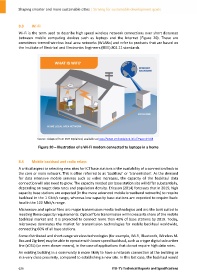Page 636 - Shaping smarter and more sustainable cities - Striving for sustainable development goals
P. 636
8.3 Wi‐Fi
Wi‐Fi is the term used to describe high speed wireless network connections over short distances
between mobile computing devices such as laptops and the Internet (Figure 20). These are
sometimes termed wireless local area networks (WLANs) and refer to products that are based on
the Institute of Electrical and Electronics Engineers (IEEE) 802.11 standards.
Source: Adapted from EMF Explained, available at http://www.emfexplained.info/?Page=24788
Figure 20 – Illustration of a Wi‐Fi modem connected to laptops in a home
8.4 Mobile backhaul and radio relays
A critical aspect to selecting new sites for ICT base stations is the availability of a connection back to
the core or main network. This is often referred to as ‘backhaul’ or ‘transmission’. As the demand
for data intensive mobile services such as video increases, the capacity of the backhaul data
connection will also need to grow. The capacity needed per base station site will differ substantially,
depending on target data rates and population density. Ericsson (2014) forecasts that in 2019, high
capacity base stations are expected (in the more advanced mobile broadband networks) to require
backhaul in the 1 Gbit/s range, whereas low capacity base stations are expected to require back‐
haul in the 100 Mbit/s range.
Microwave and optical fibre are major transmission media technologies and are the best suited to
meeting these capacity requirements. Optical fibre transmission will increase its share of the mobile
backhaul market and it is projected to connect more than 40% of base stations by 2019. Today,
microwave dominates the market for transmission technologies for mobile backhaul worldwide,
connecting 60% of all base stations.
Some distributed and short‐range wireless technologies (for example, Wi‐Fi, Bluetooth, Wireless M‐
Bus and Zig‐bee) may be able to operate with lower speed backhaul, such as x‐type digital subscriber
line (xDSL) (or even slower means), in the case of applications that do not require high data rates.
An existing building in a community is more likely to have a network connection at the building or
in a very close proximity, compared to establishing a new site. In this last case, the backhaul would
626 ITU‐T's Technical Reports and Specifications

